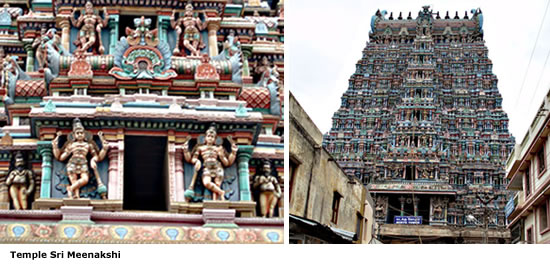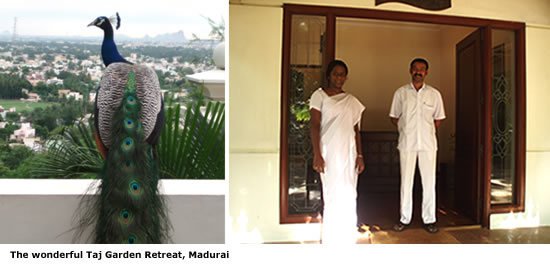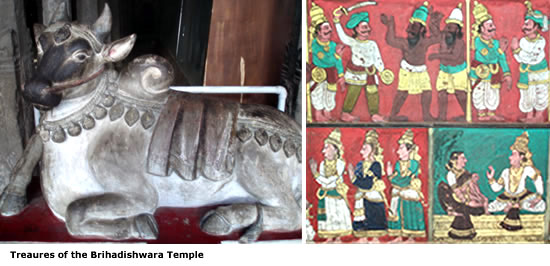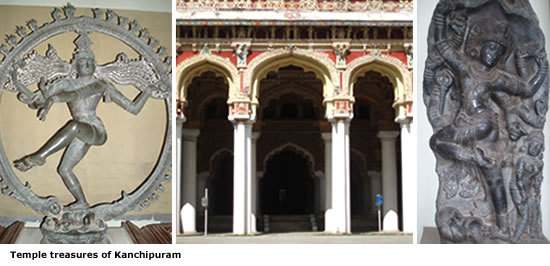Part 2: Madurai, Tanjore (Thanjavur), Pondichery & Mahabalipuram, Kanchipuram & Chennai (Madras)
Day 7 Madurai. We head deeper into Tamil Nadu provide and arrive Madurai, a bustling city famous for the “Mother of all Temples” Sri Meenakshi Temple. This 16th Century Dravidian temple complex is huge, covering over 14 acres, and when we visit it is crowded with pilgrims. It has nine towers, the largest 164 feet high. We Westerners are conspicuous and as we wander around the complex we are aware of many curious eyes that follow us.
We check into the Taj Garden Retreat Madarai, a wonderful colonial style resort perched above the city. I hurry for a swim before evening cocktails, in a beautiful pool surrounded by tropical gardens, with only the peacocks for company. Our delightful cocktail party hosted by our hotel manager and his lovely wife, takes place on a broad verandah with the lights of the city below.
Day 8 Tanjore (Thanjavur). I wake to a pink sky, the temple in the distance, and a peacock strutting on my verandah wall—and not so sublime—the blare of the towns loudspeakers blasting Indian pop music.
On to Tanjore, also known as Thanjavur, the “Rice Bowl of Tamil Nadu,” a place famous for the Brihadishwara Temple. Tanjore was the royal city of the Chola dynasty, who flourished from the 9th-12th centuries. Known as the “Big Temple,” Brihadishwara is one of Tamil Nadu’s architectural gems. There is an impressive dome over the main shrine, a profusion of sculptured paintings and an outstanding collection of Chola bronzes.
We overnight at the Sangam Hotel. In the hotel gift shop I sift through stacks of old book illustrations and paintings and find a few special ones to bring home.
Day 9 Pondichery and Mahabalipuram. On the road again, we stop for lunch at the Anandha Inn in Pondichery. This lovely seaside town was fought over and ruled by various European powers—the French, Dutch and British—from the 16th century until Independence in 1954. You see the French influence everywhere. We visit Sri Aurobindo Ashram, one of India’s best known, founded in the 1950’s by Bengali guru Aurobindo Ghose and the Mother. It is still a thriving ashram.
Mahabalipuram is Tamil Nadu’s resort area, a coastal village on the Bay of Bengal with a number of beach resorts and restaurants. It’s also a World Heritage site because of the fine folk art images carved into rock—simple scenes, unlike the complex religious images seen in the temples. The resort has revived the crafts of the Pallava sculptors and you see them with marble and chisels in shops that line the road.
We overnight at the Fisherman’s Cove Resort, one of the Taj group hotels and a very nice resort set on a lovely stretch of palm-fringed beach. In the morning I enjoyed a lovely bath in the ocean on a beautiful deserted beach, followed by a swim in the hotel pool. Especially attractive at this hotel are the cottages that are situated beachfront, amidst the palm trees and gardens.
Click here to view a slideshow ot the Madurai segment of my trip.
Day 10 Kanchipuram and Chennai (Madras). Kanchipuram, the “golden city of a thousand temples,” is considered one of the most important Hindu pilgrim centers of Southern India. It has over 70 temples. One of the largest temples features a hill with 1000 pillars with beautiful carvings in sandstone. Bas relief panels illustrate battles and scenes of courtly life.
Kanchipuram was a meeting place for the scholars of 3 great religions, Hinduism, Buddhism and Jainism, as was a major center of learning, culture and philosophy. It now houses the remains of Pallava, Chola and Vijayanagera architecture and art from the 8th to the 17th centuries. Overnight Taj Connemara hotel in Chennai (formerly known as Madras).
NEXT PAGE | Mysore in Karnataka Province, Belur and Halebid, City Palace Mysore,
Bangalore—flight home








